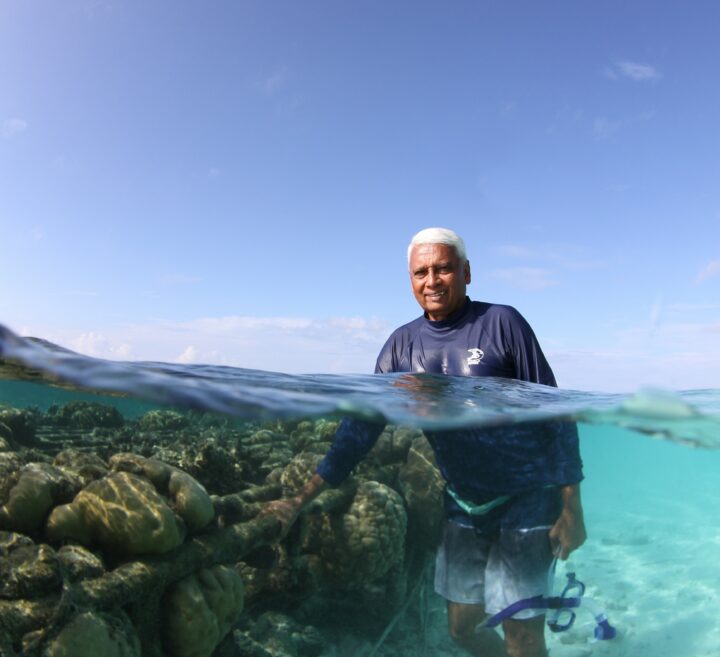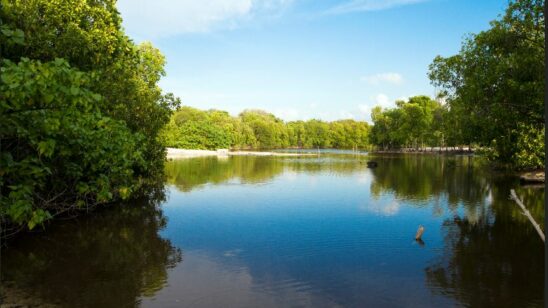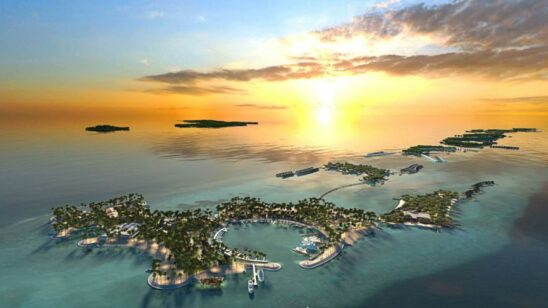
Abdul Azeez Abdul Hakeem: From The Necklace Project to Exechonella azeezi
[vc_row][vc_column][vc_column_text]Angsana Ihuru, just 35-minutes from Velana International Airport, is home to peace and quiet and one of the best house reefs in the Maldives. Unlike other resorts in North Malé Atoll, Angsana Ihuru does not feature any water-based structures, which is not surprising, as the pioneers of the island were environmentally conscious and refused to commit anything that can damage or harm the coral reef.
Though operated by Singapore-based Banyan Tree Holdings, the island was first developed and operated by a team of very enthusiastic locals and is one of the first generation of resorts to open in the country. It was the early days of tourism in the Maldives, the early seventies, when Abdul Azeez Abdul Hakeem–more familiar as N.D. Azeez–and his partners ventured into the development of Ihuru Island Resort. Today a renowned marine conservationist, it was not marine conservation or resort development that first made a mark in his career.
Like father, like son
Born in Naifaru Island of Lhaviyani Atoll, Azeez is the son of Naifaru Dhon Kaleyfaanu—a well-known traditional medicine practitioner in the Maldives. It was during his childhood, seeing his father planting trees, that sparked an interest in the science of agriculture. Encouraged to continue in his father’s footsteps, Azeez acquired higher education in the field of agriculture in Cairo Egypt. Educated in Egypt and Sri Lanka, Azeez served as Director of Agriculture at the Ministry of Agriculture in the Maldives, prior to his engagement in the hospitality industry. While serving as a civil servant, Azeez devoted most of his spare time to the project; his partners in the venture were Ahmed Adam and Ahmed Mujthaba.
“It was the very early days, there were no desalination plants and no speedboats and definitely no telephones. We started off with very basic and simple services, but it was a total hit. Mainly due to the amazing coral reef surrounding the island. It was our biggest selling point,” Azeez tells me, sitting at his office with the view of the afternoon sun bearing down on the ocean and nearby islands.
“Things started moving a bit faster with the introduction of speedboats and better communication facilities. We introduced better facilities and services and upgrade the island. We operated the island until 2000 after which we rented it out.”
Now managed as Angsana Ihuru, the island remains an epitome of best practice in the Maldives’ tourism industry. Barely three hectares in size and the island is round and perfectly formed with white powdery beaches and lush vegetation. It was one of the most photographed islands by the German photographer Michael Friedel who came to the Maldives in the early seventies as a ‘destination scout’ for European travel agents looking for emerging long-haul holiday destinations throughout the world.
Ihuru remains with the original 43 villas built on the island. It’s remarkable that over 90 per cent of its staff is local despite being managed by one of the world’s most luxurious hotel brands for the last 20 years. Some of the staff working on the island have been employed for over 20 years while several more are working for over a decade. For many, this was also the first resort they were employed and never wanted to try out working on a different property.
Azeez is no longer involved in the day to day operations of the property although heavily invested in the manner it is run and especially how the natural and pristine environment of the island is preserved. For an island in Malé Atoll, Ihuru remains remarkably pristine and natural. The absence of water villas, the natural beach, and the preservation of old vegetation and trees and the conservation of the natural coral reef surrounding the island gives it a unique quality that makes it seem millions of years away from the more urbanised and artificially developed islands in the atoll.[/vc_column_text][/vc_column][/vc_row][vc_row][vc_column][vc_images_carousel images=”21179,21175,21176,21177,21178″ img_size=”full” speed=”3000″ autoplay=”yes” hide_pagination_control=”yes” hide_prev_next_buttons=”yes” wrap=”yes”][/vc_column][/vc_row][vc_row][vc_column][vc_column_text]
The Necklace Project
Azeez’s pride and joy is the “The Necklace Project”; an innovative project initiated 21 years ago, at Ihuru Resort which sought to prevent beach erosion. “I was assisting a friend, looking after two visiting scientists, when they introduced me to an experiment they were trying out in the Caribbean,” says Azeez, explaining the inception of the project. “Though their project was not very successful as the Caribbean was prone to hurricanes and strong currents, I thought it was very simple, and one which we can employ here.”
Once he got the go-ahead from his partners, and with all the equipment, it just took him three days to create the structure out of steel and titanium rods and place it in the water. It was carried out with the technical assistance of Professor Wolf Hilbertz and Dr Tom Goreau. “The aim of the project was to see if the structure could withstand storms and helps in breaking strong wave energy, and prevent beach erosion,” he says.
It is a steel structure 40 metres long and 4 metres wide, fixed inside the lagoon at a depth of 0.5 metres. Massive corals were initially put on top of the structure to stabilise it. The steel structures were provided with low voltage direct current which causes the growth of calcium carbonate, dissolved in seawater over the steel surfaces, which are completely protected from corrosion. The growing calcium carbonate on the steel structure, which has already achieved a thickness of about 20 centimetres in diameter in some places, now acts as a natural barrier to strong waves.
“We cut the power supply from the structure after five years. It had already turned into a strong structure, perfect for the corals to grow. During rough weather, it acts as a protective barrier from strong waves, breaking the energy before it reaches the beach. The necklace has become the perfect haven for corals, and for fish and other forms of marine life,” adds Azeez.
“But lately, the necklace has fallen victim to coral bleaching. It is very sad to see that today, some of the smaller corals on the structure are now dead. But surprisingly, the massive corals you find there are still alive and thriving.”
The necklace was incepted over 20 years ago, and today, with numerous advancements in technology, the possibilities of re-enacting similar coral barriers are numerous. From utilising advancements in modern technology like stronger batteries and solar energy, such barriers can be developed to stand-alone and are self-maintained. They can be placed anywhere in the lagoon, without the requirement of long and expensive cables connecting with the powerhouse. As Azeez sees it, this can be a very low-cost project, that can have numerous advantages when it comes to environmental protection and conservation.[/vc_column_text][/vc_column][/vc_row][vc_row][vc_column][vc_images_carousel images=”21185,21184,21183,21182,21181,21180″ img_size=”full” speed=”3000″ autoplay=”yes” hide_pagination_control=”yes” hide_prev_next_buttons=”yes” wrap=”yes”][/vc_column][/vc_row][vc_row][vc_column][vc_column_text]
The Eco-warrior
The necklace project is not the only thing Azeez is known for. He is a true marine conservationist, one whose name is engraved in marine biology and history books. He is also the first Maldivian to have a new Bryozoan species named after him – the Exechonella azeezi. “I was conducting research with scientists from the University of Austria. We were conducting a study of Bryozoan species in Maldivian waters when we discovered a new species,” he explains.
“A couple of years later, authorities confirmed that the new finding was, in fact, a new species of Bryozoan. And the head of the scientific mission decided to name the new species after me.” The new species was named after Azeez for his dedication in environment conservation, creating awareness, and for his generous support and help to many scientists visiting the Maldives.
He also co-published a diving guide in 1996 called the Maldives Diving Guide, alongside world-famous photographer Kurt Amsler and Khalida Hassan. Azeez is also the architect behind one of the country’s first marine laboratory opened in Banyan Tree Vabbinfaru, which focused on electrical reefs, conservation of turtles, and other marine life in addition to educating school children. He served as the director of conservation for Banyan Tree Vabbinfaru for over six years.
His name also goes in the history books as one of the first to document coral spawning in the Maldives. “I was leading the team. It was a daunting task, as corals spawn only once every year between April and March during the full moon. There was no way to tell which night it would happen,” says Azeez, excited to witness the phenomenon.
“We monitored the sites for five long nights. It was the fifth night when the miracle happened. It was a very special moment, to witness the event and catch it on camera,” Azeez adds, who has a certain keenness to diving, in addition to other sports including cricket and badminton.
The marine conservationist will be one with the spotlight at the upcoming Hotelier Maldives GM Forum 2019. The event will see a special presentation on sustainable tourism and conversation, with a case study on the necklace project. The GM Forum is scheduled to be held in Bandos Maldives on April 3, 2019.[/vc_column_text][/vc_column][/vc_row]





